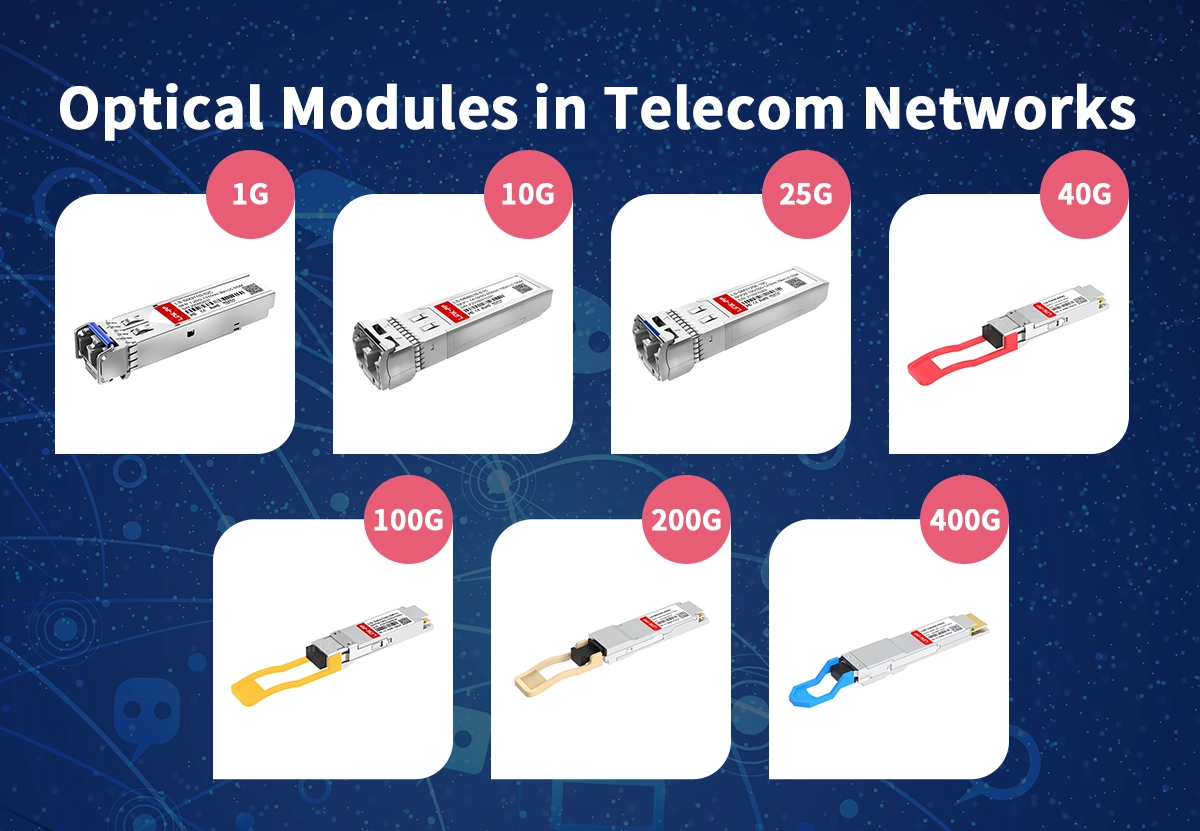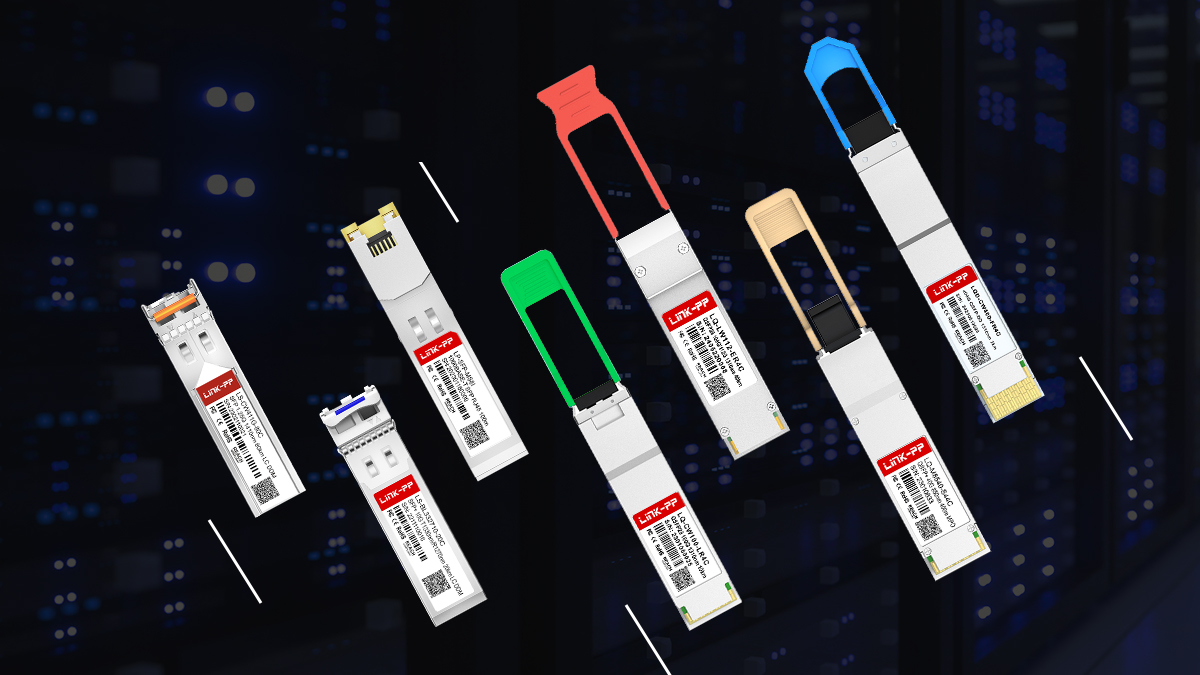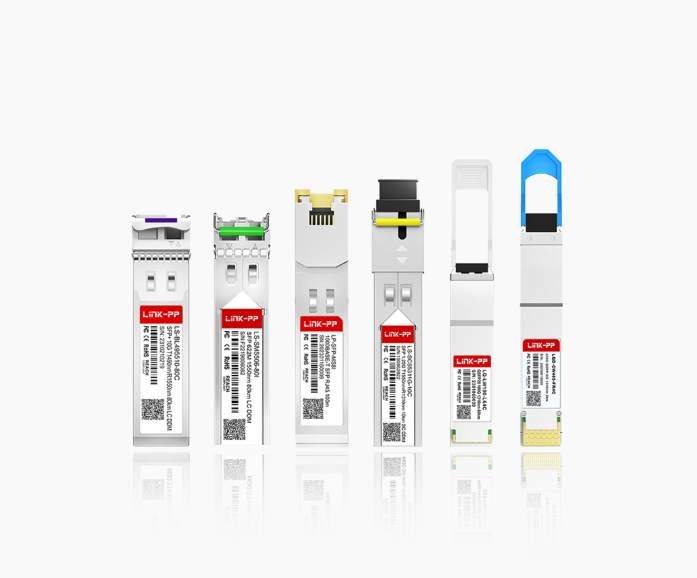
✅ Overview: Why Optical Modules Are Fundamental to Modern Telecom
Optical modules, also known as optical transceivers, are essential components that convert electrical signals to optical signals and vice versa. They form the backbone of long-distance, high-capacity data transport in modern telecom networks. Deployed across fronthaul, midhaul, and backhaul segments, optical modules support the growing demands for bandwidth, low latency, precise synchronization, and high port density driven by 5G, cloud services, and edge computing.
✅ Where Optical Modules Fit in the Network
1. Fronthaul: The Most Latency-Sensitive Segment
Fronthaul links connect Radio Units (RUs) to Distributed Units (DUs). These links demand ultra-low latency and strict synchronization, requiring modules with minimal jitter and precise timing. Small form-factor modules like SFP28/25G or short-reach BiDi optics are commonly used. Interface standards such as CPRI and eCPRI define the capacity and latency budget for fronthaul connections.
2. Midhaul: Aggregation With Moderate Latency
Midhaul connects DUs to Centralized Units (CUs), aggregating multiple fronthaul streams. While latency requirements are less strict than fronthaul, higher aggregated bandwidth is needed. Operators typically use 25G/50G SFP28/SFP56 or 100G QSFP modules, depending on site scale.
3. Backhaul: Capacity-Driven Core Connectivity
Backhaul links transport data from the RAN aggregation or centralized units to the core network or data centers. They prioritize capacity and distance. High-speed modules such as QSFP28, QSFP56, or QSFP-DD, often combined with DWDM technology, maximize fiber utilization. Backhaul modules focus on high throughput, multi-wavelength support, and system interoperability.
✅ Key Technical Requirements for Telecom Optical Modules
Throughput and Form Factor
Form factors like SFP, SFP+, SFP28, and QSFP28 correspond to specific data rates (1G→SFP, 10G→SFP+, 25G→SFP28, 100G→QSFP28). Selecting the right form factor ensures optimal balance between port density, power consumption, and line rate.
Latency, Jitter, and Synchronization
In fronthaul applications, links must maintain precise timing and minimal jitter. eCPRI split architectures reduce bandwidth compared to legacy CPRI but still require low latency, meaning modules must support tight timing and low per-hop delays.
Reach and Multiplexing (CWDM/DWDM)
Backhaul often requires long-reach single-mode fiber and wavelength multiplexing. DWDM or CWDM-capable modules allow operators to maximize capacity on limited fiber infrastructure.
Environmental and Operational Specs
Telecom deployments demand industrial-grade temperature ranges, DOM (digital optical monitoring), extended MTBF, and compliance with SFF/MSA specifications. Outdoor and remote installations require modules that tolerate wide temperature swings and constrained power.
✅ Standards and Interfaces
Telecom optical modules are governed by IEEE Ethernet standards (25G/50G/100G), SFF MSA form-factor definitions, and transport interfaces like CPRI/eCPRI. These standards define electrical and optical characteristics, interoperability, and feature sets, ensuring modules meet network requirements.
✅ Deployment Considerations
Right-sizing Form Factor: Use small-form-factor SFP28 for dense fronthaul/midhaul and QSFP modules for high-capacity backhaul.
Interoperability: Modules should meet SFF/MSA standards and support DOM for field reliability.
Upgrade Paths: Modular optics simplify upgrades and allow DWDM or tunable solutions to extend fiber utilization without replacing line cards.
✅ LINK-PP Product Fit for Telecom

LINK-PP provides a wide range of optical modules suitable for telecom applications. Their catalog includes SFP, SFP+, and SFP28 modules designed for fronthaul, midhaul, and backhaul deployments. Examples include long-reach 10G BiDi SFP+ and mid-rate SFP transceivers with industrial temperature support. Products can be explored on the LINK-PP optics store.
✅ Future Outlook: From 5G to 6G and Edge Cloud
Optical modules will continue to evolve with higher per-lane speeds, coherent optics for metro/backbone networks, and intelligent photonics. These advances will be critical for ultra-low latency applications, edge computing, and future 6G networks. Operators should plan modular upgrades to adapt to evolving traffic and service demands.
✅ Quick Checklist for Choosing Telecom Optical Modules
Select the right form factor (SFP/SFP28/QSFP) for required line rate and port density.
Verify fronthaul latency and timing budgets (CPRI/eCPRI).
Ensure DOM, industrial temperature support, and vendor compliance.
Consider tunable or DWDM modules if fiber is limited.
✅ Conclusion
Optical modules are the foundation of modern telecom networks, supporting 5G traffic between radios, aggregation points, and core networks while meeting stringent requirements for bandwidth, latency, and reliability. Selecting the appropriate modules — considering form factor, standards, timing, and environment — enables scalable, future-ready telecom networks. LINK-PP’s compliant and versatile optical products help operators deploy high-performance, reliable networks efficiently.




